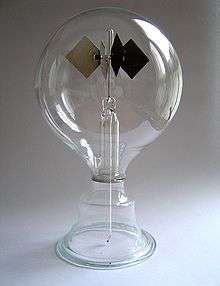Radiometer

A radiometer or roentgenometer is a device for measuring the radiant flux (power) of electromagnetic radiation. Generally, a radiometer is an infrared radiation detector or ultraviolet detector.[1]
The name Radiometer is frequently used to refer to a Crookes radiometer ("light-mill"), an early model device wherein a rotor (having vanes which are dark on one side, and light on the other) in a partial vacuum spins when exposed to light. A common myth (one originally held even by Crookes) is that the momentum of the absorbed light on the black faces makes the radiometer operate. If this were true however, the radiometer would spin away from the non-black faces, since the photons bouncing off those faces impart more momentum than the photons absorbed on the black faces. Photons do exert radiation pressure on the faces, but those forces are dwarfed by other effects. The final explanation depends on having just the right degree of vacuum, and is more related to the transfer of heat than the direct effect of photons. [2]
The Nichols radiometer operates on a different principle and is more sensitive than the Crookes type.
A microwave radiometer operates in the microwave wavelengths. The radiometer contains argon gas to enable it to rotate.
The MEMS radiometer, invented by Patrick Jankowiak, can operate on the principles of Nichols or Crooke and can operate over a wide spectrum of wavelength and particle energy levels.[3]
See also
- Radiation pressure
- Net radiometer
- Bolometer
- Pyranometer
- Radiometry
- Spectroradiometer
- Copernicus
- Solar sail
- Photon rocket
- Active cavity radiometer
References
- ↑ http://sensing.konicaminolta.us/2013/11/what-is-the-difference-between-radiometers-spectrometers-and-spectroradiometers]
- ↑ Explanation of Crooke's Radiometer
- ↑ MEMS Radiometer United States Patent 7,495,199
External links
| Wikimedia Commons has media related to Radiometer. |
- https://www.youtube.com/watch?v=teEhoUB-FQE&list=UUXrJjdDeqLgGjJbP1sMnH8A Short video pertinent to the topic.